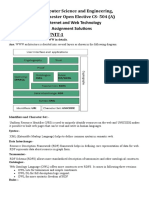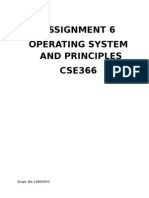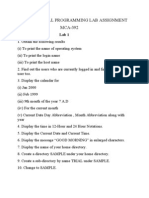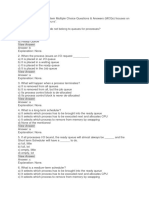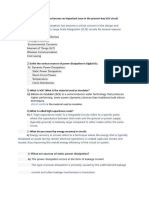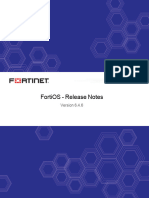07f ch4 Testbank
07f ch4 Testbank
Uploaded by
gerardopineda1366Copyright:
Available Formats
07f ch4 Testbank
07f ch4 Testbank
Uploaded by
gerardopineda1366Original Description:
Original Title
Copyright
Available Formats
Share this document
Did you find this document useful?
Is this content inappropriate?
Copyright:
Available Formats
07f ch4 Testbank
07f ch4 Testbank
Uploaded by
gerardopineda1366Copyright:
Available Formats
Operating Systems, 5th ed.
Chapter 4 Threads, SMP, and Microkernels True / False Questions:
Chapter 4
1. T / F The basic unit of dispatching in an operating system is usually referred to as a thread or lightweight process. ANS: T 2. T / F An example of a system that implements a single process with multiple threads is MS-DOS. ANS: F (Java) 3. T / F In a multithreaded environment, a process is defined as the unit of resource allocation and a unit of protection. ANS: T 4. T / F The concept of thread synchronization is required in multithreaded systems because threads of a single process share the processs process control block (PCB). ANS: F (because they share the same address space) 5. T / F In a pure User-Level Thread (ULT) facility, all of the work of thread management is done by the application, but the kernel is aware of the existence of threads. ANS: F (kernel is not aware of the threads existence) 6. T / F In the field of distributed operating system design, the One-to-Many (Thread-to-Process) relationship is particularly interesting because it involves the concept of thread migration. ANS: T 7. T / F One disadvantage to the master/slave shared-memory multiprocessor architecture is that the failure of the master brings down the whole system. ANS: T 8. T / F In a symmetric multiprocessing (SMP) system, each processor has access only to a private main memory area. ANS: F (also have access to a shared main memory)
Page 1 of 7
Operating Systems, 5th ed.
Chapter 4
9. T / F An SMP O/S manages processor and other resources so that the user may view the system in the same fashion as a multiprogramming uniprocessor system. ANS: T 10. T / F The primary advantage of the basic microkernel design over layered kernel designs involves increased performance. ANS: F (performance is a disadvantage) 11. T / F The philosophy underlying the microkernel is that only absolutely essential core operating system functions should be in the kernel. ANS: T 12. T / F The basic form of communication between processes or threads in a microkernel O/S is messages. ANS: T 13. T / F Linux makes no distinction between a process and a thread. ANS: T 14. T / F Windows 2000 is an object-oriented O/S, but only processes (not threads) are implemented as objects in the WIN2K O/S. ANS: F (threads are also implemented as objects) 15. T / F In the Solaris O/S, a User-Level Thread (ULT) in the active state is assigned to a Light-Weight Process (LWP) and executes while the underlying kernel thread executes. ANS: T
Page 2 of 7
Operating Systems, 5th ed.
Chapter 4
Multiple Choice Questions: 1. The concept of a process in an operating system embodies two primary characteristics, one of which is: a. b. c. d. Multithreading Resource ownership Symmetric multiprocessing None of the above
ANS: B 2. An example of a system that implements a single process with multiple threads is: a. b. c. d. WIN 2000 Solaris Java All of the above
ANS: C 3. Which of the following is true regarding the relationship between processes and threads: a. It takes far less time to create a new thread in an existing process than to create a new process b. It takes less time to terminate a process than a thread c. It takes less time to switch between two different processes than to switch between two threads within the same process d. All of the above ANS: A 4. The basic thread operation related to the change in thread state that occurs when a thread needs to wait for an event is referred to as the: a. b. c. d. Unblock operation Spawn operation Block operation None of the above
ANS: C
Page 3 of 7
Operating Systems, 5th ed.
Chapter 4
5. One of the disadvantages of User-Level Threads (ULTs) compared to KernelLevel Threads (KLTs) is: a. Scheduling is application specific b. When a ULT executes a system call, all threads in the process are blocked c. Thread switching does not require kernel mode privileges d. All of the above ANS: B 6. In the Linux O/S, multiple threads may be created and executed within a single process. This is an example of the following Thread-to-Process relationship: a. b. c. d. 1:1 1:M M:N None of the above
ANS: D (M:1) 7. The computer system category where a single processor executes a single instruction stream to operate on data stored in a single memory is called: a. b. c. d. Single Instruction Single Data (SISD) stream Single Instruction Multiple Data (SIMD) stream Multiple Instruction Single Data (MISD) stream None of the above
ANS: A 8. In a SMP system, each processor maintains a local cache and must alert all other processors that a change to cache has taken place. This is referred to as the: a. b. c. d. Interconnection mechanism problem Synchronization mechanism problem Cache coherency problem None of the above
ANS: C 9. Key issues involved in the design of multiprocessor operating systems include: a. Scheduling b. Synchronization
Page 4 of 7
Operating Systems, 5th ed. c. Reliability and fault tolerance d. All of the above ANS: D
Chapter 4
10. Early operating systems that were designed with little concern about structure are typically referred to as: a. b. c. d. Monolithic operating systems Layered operating systems Kernel operating systems All of the above
ANS: A 11. A benefit of the microkernel organization is: a. b. c. d. Extensibility Portability Flexibility All of the above
ANS: D 12. In a Solaris system, a User-Level Thread (ULT) that enters the active state is assigned to a: a. b. c. d. Kernel thread Heavy-Weight Process (HWP) Light-Weight Process (LWP) None of the above
ANS: C
Page 5 of 7
Operating Systems, 5th ed.
Chapter 4
Fill-In-The-Blank Questions: 1. In an operating system, the unit of dispatching is usually referred to as a ___________________, while the unit of resource ownership is usually referred to as a process or task. ANS: thread or lightweight process 2. An example of an operating system that supports a single user process and a single thread is _______________. ANS: MS-DOS 3. An example of an operating system that supports multiple user processes and multiple threads is _______________. ANS: WIN2K/Solaris/Linux/Mach/OS2 4. It is necessary to ___________________ the activities of various threads so they do not interfere with each other or corrupt data structures. ANS: synchronize 5. A process that cannot execute until some event occurs is said to be in the _______________ state. ANS: blocked 6. The Clouds O/S implements the concept of a thread as primarily an entity that can move among address spaces which represents the _______ Thread-toProcess relationship. ANS: One-to-Many 7. In a ________________ system, the kernel can execute on any processor, and typically each processor does self-scheduling from the pool of available processes or threads. ANS: symmetric multiprocessor 8. In most modern computer systems, processors generally have at least one level of __________________ that is private to the processor. ANS: cache memory
Page 6 of 7
Operating Systems, 5th ed.
Chapter 4
9. With multiple active processes in an SMP system having potential access to shared address space or shared I/O resources, care must be taken to provide effective _________________. ANS: synchronization 10. In the ________________ O/S architecture, functions are organized hierarchically and interaction only takes place between adjacent sections. ANS: layered 11. One advantage of the microkernel architecture is __________________, allowing the addition of new services as well as the provision of multiple services in the same functional area. ANS: extensibility 12. The basic form of communication between processes or threads in a microkernel O/S is __________________ . ANS: messages 13. In a Linux system, if the process has been terminated but, for some reason, still must have its task structure in the process table is in the _____________ state. ANS: zombie 14. In a Solaris system, a User-Level Thread (ULT) in the active state is assigned to a(n) ____________________, and executes while the underlying kernel thread executes. ANS: light-weight process (LWP) 15. In a Windows 2000 system, a process that has been selected to run next on a particular processor moves from the Ready state to the _____________ state. ANS: Standby
Page 7 of 7
You might also like
- Inclusive Components - Heydon Pickering PDFDocument315 pagesInclusive Components - Heydon Pickering PDFDmitriy LesikNo ratings yet
- Lect 1Document63 pagesLect 1Anonymous RPGElSNo ratings yet
- Guide To Operating Systems SecurityDocument2 pagesGuide To Operating Systems SecurityshashahayesNo ratings yet
- C++ Test BankDocument15 pagesC++ Test Bankjocansino100% (2)
- CN3032 Databases TutorialDocument3 pagesCN3032 Databases TutorialTendai ChingeyaNo ratings yet
- Client Server Architecture A Complete Guide - 2020 EditionFrom EverandClient Server Architecture A Complete Guide - 2020 EditionNo ratings yet
- 07f ch3 TestbankDocument8 pages07f ch3 Testbankgerardopineda1366100% (1)
- Assignment Solutions IwtDocument12 pagesAssignment Solutions IwtMr. Anidra KatiyarNo ratings yet
- Operating System Questions MCQDocument13 pagesOperating System Questions MCQSwetha D75% (4)
- Operating SystemDocument66 pagesOperating SystemRakesh K R100% (1)
- CH 03 The Relational Database Model (Short)Document5 pagesCH 03 The Relational Database Model (Short)1081李旻峰No ratings yet
- Chapter1:operating System, Quiz With AnswersDocument2 pagesChapter1:operating System, Quiz With AnswersAden Kheire MohamedNo ratings yet
- Operating System MCQDocument22 pagesOperating System MCQChetanTiwari100% (1)
- OS - All-5-UnitDocument185 pagesOS - All-5-UnithariNo ratings yet
- PHP With Mysql Material-1Document63 pagesPHP With Mysql Material-1Vijay DhamaNo ratings yet
- DOS CommandsDocument19 pagesDOS CommandsDharmendra Koguru100% (1)
- 98-361 Lesson01 GuideDocument11 pages98-361 Lesson01 GuideSiskaCahayaSholichahNo ratings yet
- Database RevisionDocument10 pagesDatabase RevisionSergio YazNo ratings yet
- IT MCQ CombinedDocument49 pagesIT MCQ CombinedARAVIND KNo ratings yet
- Operating System MCQsDocument64 pagesOperating System MCQszariNo ratings yet
- Operating System Exercises - Chapter 5-ExrDocument2 pagesOperating System Exercises - Chapter 5-ExrevilanubhavNo ratings yet
- Bank IT Officer: Operating System Question AnswerDocument4 pagesBank IT Officer: Operating System Question AnswerAsim MahatoNo ratings yet
- CS301 Finalterm Subjective 2013 Solved - 2Document16 pagesCS301 Finalterm Subjective 2013 Solved - 2Network Bull100% (2)
- Lab Manual PHPDocument84 pagesLab Manual PHPtayeNo ratings yet
- Fundamentals of Python: First Programs Second Edition: Week 5 (Chapter 5)Document46 pagesFundamentals of Python: First Programs Second Edition: Week 5 (Chapter 5)Hamza KhanNo ratings yet
- Fundamentals of Database Management SystemDocument4 pagesFundamentals of Database Management SystemAmit JainNo ratings yet
- Fundamentals of DBS - CH - 2Document28 pagesFundamentals of DBS - CH - 2DesyilalNo ratings yet
- Unit-3 - Advanced Operating Systems-23pcsce24-3Document15 pagesUnit-3 - Advanced Operating Systems-23pcsce24-3Friends of GADGETSNo ratings yet
- Cs3461-Os Lab - 2021 RDocument3 pagesCs3461-Os Lab - 2021 RArunsunai ComputerNo ratings yet
- Database - Management - System - Case - Studies Hospital1Document3 pagesDatabase - Management - System - Case - Studies Hospital1ceupritNo ratings yet
- Swap Space ManagementDocument5 pagesSwap Space ManagementHarshu KummuNo ratings yet
- Chapter 8 - QuizDocument4 pagesChapter 8 - QuizPJ GapeNo ratings yet
- Unit 1-MCQ-DVDocument5 pagesUnit 1-MCQ-DVLovely Naveen NSKNo ratings yet
- Operating Systems Interview QuestionsDocument15 pagesOperating Systems Interview QuestionsSachin NayeeNo ratings yet
- QA Chapter1Document2 pagesQA Chapter1Anthony CarmeloNo ratings yet
- UNIX Question Bank - Final PDFDocument6 pagesUNIX Question Bank - Final PDFAjay KumarNo ratings yet
- Database Design Schema RefinementDocument74 pagesDatabase Design Schema RefinementPurushothama ReddyNo ratings yet
- Unit 5 - Database Management System - WWW - Rgpvnotes.inDocument24 pagesUnit 5 - Database Management System - WWW - Rgpvnotes.inmroriginal845438No ratings yet
- Dmbi Mcqs Mcqs For Data Mining and Business IntelligenceDocument24 pagesDmbi Mcqs Mcqs For Data Mining and Business IntelligenceYohan MalshikaNo ratings yet
- Data DesignDocument18 pagesData DesignNidhi Nirav BaldhaNo ratings yet
- Nav 6Document6 pagesNav 6shailesh singhNo ratings yet
- Midterm Review: CMSC 421 Fall 05Document75 pagesMidterm Review: CMSC 421 Fall 05asdNo ratings yet
- CA 2marksDocument41 pagesCA 2marksJaya ShreeNo ratings yet
- 3NF - Canonical CoverDocument3 pages3NF - Canonical CoverBrindha IlangoNo ratings yet
- Distributed File Systems: Unit - V Essay QuestionsDocument10 pagesDistributed File Systems: Unit - V Essay Questionsdinesh9866119219No ratings yet
- Transport Layer - Computer Networks Questions & Answers - SanfoundryDocument4 pagesTransport Layer - Computer Networks Questions & Answers - SanfoundryMd Rakibul Islam100% (1)
- OS Multiple Choice QuestionsDocument6 pagesOS Multiple Choice QuestionsSheena MohammedNo ratings yet
- Computer Architecture MCQDocument8 pagesComputer Architecture MCQVishal ThakurNo ratings yet
- Lab ExercisesDocument10 pagesLab Exerciseschanchalghosh80No ratings yet
- Lab 2Document6 pagesLab 2Vijay KumarNo ratings yet
- UNIX Question Bank - FinalDocument6 pagesUNIX Question Bank - FinalramalalliNo ratings yet
- Transactions Solved Questions Answers PDFDocument7 pagesTransactions Solved Questions Answers PDFSajanAndyNo ratings yet
- CN Lab ManualDocument131 pagesCN Lab ManualDHARSHINI SNo ratings yet
- DBMS Interview Questions - AnswersDocument3 pagesDBMS Interview Questions - AnswersApurba PanjaNo ratings yet
- Ps Exam: Data Structures & Algorithms - Multiple Choice Questions (MCQS) - Objective Set 2Document9 pagesPs Exam: Data Structures & Algorithms - Multiple Choice Questions (MCQS) - Objective Set 2Nikshita RajanNo ratings yet
- Operating System - Processes: ProcessDocument3 pagesOperating System - Processes: ProcessMd. Ebna Amir Foysal 152-35-1147No ratings yet
- This Set of Operating System Multiple Choice QuestionsDocument13 pagesThis Set of Operating System Multiple Choice QuestionsUsama ArshadNo ratings yet
- Chapter - 7 Distributed Database SystemDocument58 pagesChapter - 7 Distributed Database SystemdawodNo ratings yet
- OS MCQ Set 3Document4 pagesOS MCQ Set 3Sudhanshu SinghNo ratings yet
- Phonebook Java ProgramDocument4 pagesPhonebook Java ProgramIzaac Garcilazo0% (2)
- Sheet4 SolutionDocument2 pagesSheet4 Solutioninosta11111No ratings yet
- Sheet 4 2020Document3 pagesSheet 4 2020Rago RagoNo ratings yet
- EE6008Document102 pagesEE6008St. Anne's CET (EEE Department)No ratings yet
- DSA Sheet by Arsh (45 Days Plan) - Sheet1Document7 pagesDSA Sheet by Arsh (45 Days Plan) - Sheet1Kriti ChawreNo ratings yet
- MIL Lesson 2 Evolution of MediaDocument31 pagesMIL Lesson 2 Evolution of MediaKenny Russel DinNo ratings yet
- An Empirical Study of Commercial Antivirus Software EffectivenessDocument11 pagesAn Empirical Study of Commercial Antivirus Software Effectivenessuser_2902551No ratings yet
- Atp Ict Mock 4 2-1bDocument17 pagesAtp Ict Mock 4 2-1benzosou68No ratings yet
- Lab03 ProcessesDocument19 pagesLab03 ProcessesRuba BdraniNo ratings yet
- Free Cisco CoursesDocument4 pagesFree Cisco CoursesLeslie CatindigNo ratings yet
- Lowpower Vlsi Design.Document5 pagesLowpower Vlsi Design.NareshNo ratings yet
- Tushar - DSU - 1 2 3 4 5 6Document10 pagesTushar - DSU - 1 2 3 4 5 6tusharedits07No ratings yet
- History of ContainerisationDocument1 pageHistory of ContainerisationKristian PacquingNo ratings yet
- Circuit Switching Has More Advantage Than Packet Switching For Pcs. A) TrueDocument6 pagesCircuit Switching Has More Advantage Than Packet Switching For Pcs. A) TruePRABHAKAR MORENo ratings yet
- A Blockchain Based System For Healthcare Digital TwinDocument54 pagesA Blockchain Based System For Healthcare Digital Twinbvishal27No ratings yet
- Usingcontrol MatlabDocument1,626 pagesUsingcontrol MatlabGjergjiNo ratings yet
- Catalog Easy Harmony ET6Document13 pagesCatalog Easy Harmony ET6tridata triNo ratings yet
- Deepika ResumeDocument3 pagesDeepika Resumemiss_jyoti_kapoorNo ratings yet
- Fundamentals of Information System (IS)Document104 pagesFundamentals of Information System (IS)natiman090909No ratings yet
- Assignment 3 - The IT SystemDocument12 pagesAssignment 3 - The IT SystemNathanNo ratings yet
- Fortios v6.4.6 Release NotesDocument56 pagesFortios v6.4.6 Release NotesAberfoyle SpringNo ratings yet
- JD Kyndryl - Associate Technical Engineer 1Document2 pagesJD Kyndryl - Associate Technical Engineer 1Nanda LuckyNo ratings yet
- DCN Full PDFDocument116 pagesDCN Full PDFBabuNo ratings yet
- CX7 User Guide V1.6Document34 pagesCX7 User Guide V1.6marydarl444No ratings yet
- Learn Java - String Methods Cheatsheet - Codecademy PDFDocument4 pagesLearn Java - String Methods Cheatsheet - Codecademy PDFabhi yadavNo ratings yet
- A Review On Feature Selection in Mobile Malware DetectionDocument16 pagesA Review On Feature Selection in Mobile Malware Detectionshivam kumarNo ratings yet
- SDR-KIT 980 Module: FeaturesDocument2 pagesSDR-KIT 980 Module: FeaturesOscar MontañezNo ratings yet
- Networks Security Quiz - March 2024 With AnswersDocument8 pagesNetworks Security Quiz - March 2024 With Answersamir8ahamdNo ratings yet
- Ciena 6200 Packet Optical Platform Data SheetDocument4 pagesCiena 6200 Packet Optical Platform Data SheetĐạt Hoa PhúcNo ratings yet
- Log Cat 1687712139506Document108 pagesLog Cat 1687712139506deaz calejoNo ratings yet
- Ga14 Evolution Computations On C#Document11 pagesGa14 Evolution Computations On C#Ioachim DipseNo ratings yet







